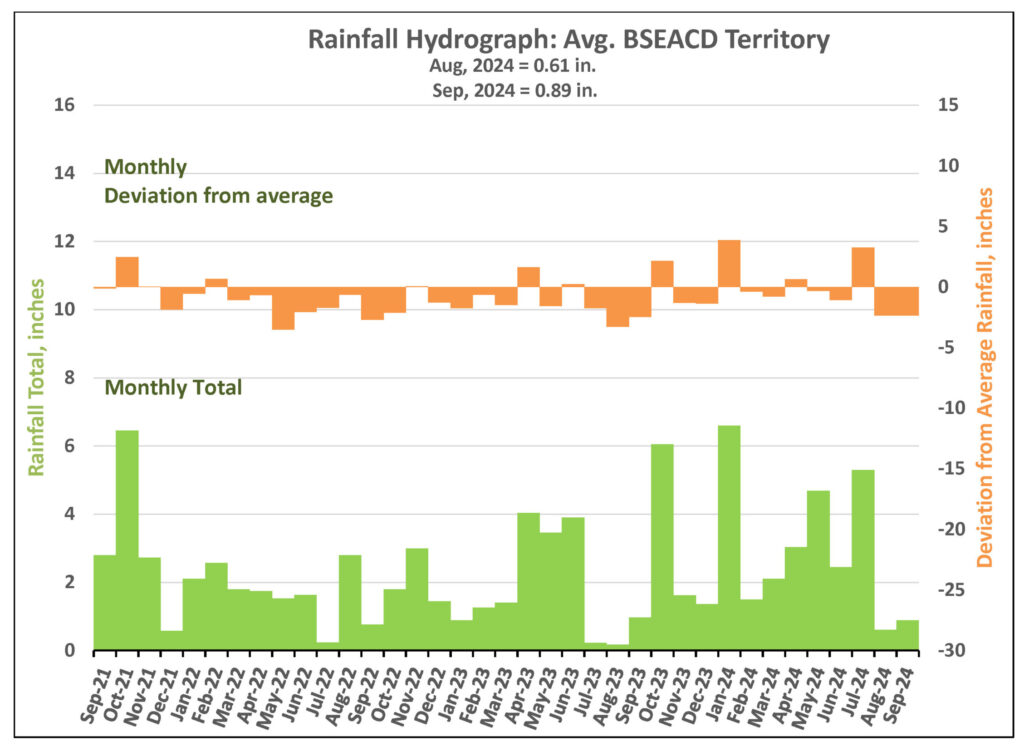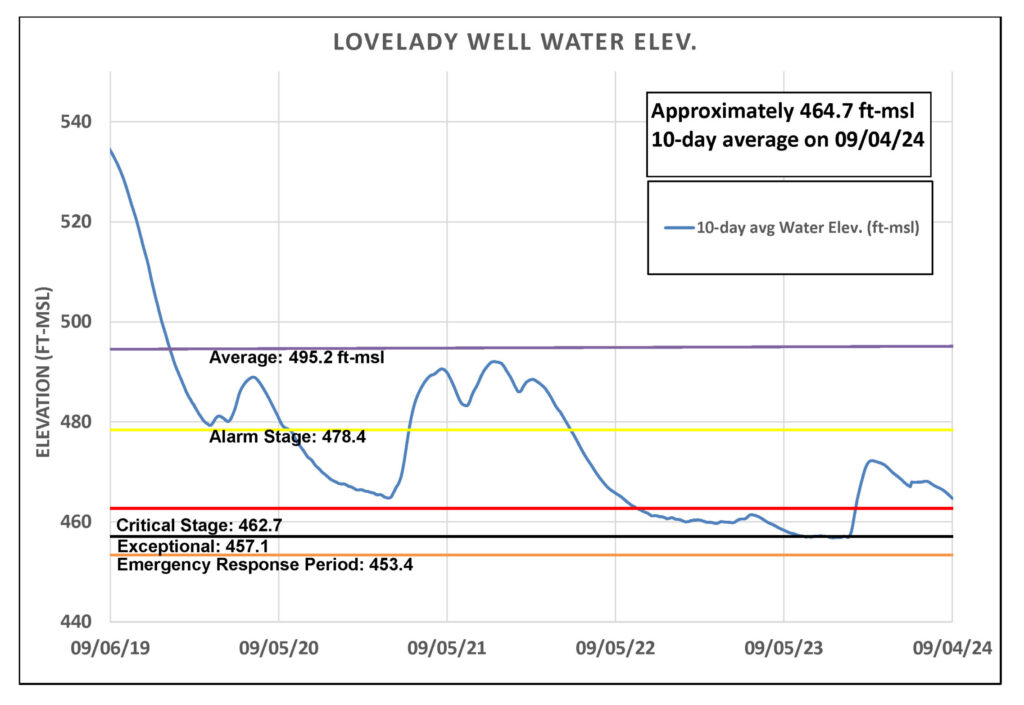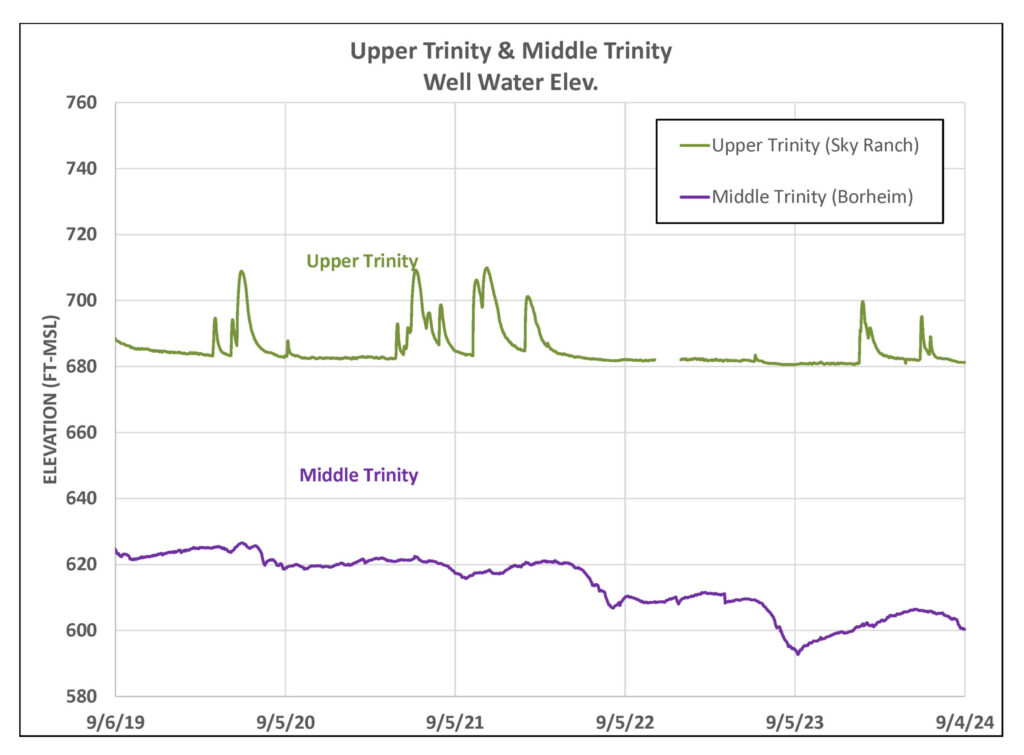The month of August brought the District above average temperatures and below average rainfall, which resulted in continued decline in both Barton Springs flow and Lovelady monitor well levels. Camp Mabry hit 109°F on August 21, breaking the previous record high of 107°F set in 1925. The average temperature for the month was 88°F (including highs and lows), making it 1.5°F above the average for August.
Rainfall
This month, the District received an average of 0.6 inches of rain, 2.4 inches below the August historical average. While August brought minimal rainfall, it also brought the usual debilitating heat and the hottest day of 2024. This combination has led to a quick decline to both aquifer levels and spring flow. Through August we’re experiencing a 0.5 inch surplus of rainfall for 2024 but remain at a 16-inch rain deficit over the last 24 months.

Groundwater Levels and Spring Flow

District drought chart showing the 10-day averages for Barton Springs flow and Lovelady monitor well water levels.
Barton Springs Flow
As of September 5, Barton Springs maintains a 10-day average flow of 22 cubic feet per second (cfs), only slightly above the Stage III Critical Drought threshold of 20 cfs (figure 2). With recent rainfall barely exceeding half an inch, flow conditions are edging closer to the threshold. Early September brought some relief with 1.2 inches of rain across the District – primarily southwest of Austin. Yet, without substantial precipitation, Barton Springs’ flow could drop below the Stage III Critical Drought threshold before the month ends.
In late August, you may have noticed large fluctuations in Barton Springs flow on the USGS gauge. This was a result of two holes in an existing abandoned pipe from the 1940s in the pool. The holes were pulling water into another pipe below the pool’s dam making it unsafe for visitors. A temporary fix was put into place, but the City is now actively working towards a more permanent solution. Barton Springs Pool will remain closed for several weeks as the issue is resolved.
District, USGS, and City of Austin staff are taking more frequent manual measurements of Barton Springs flow in response to these fluctuations and the springs nearing the Stage III Critical Drought threshold.

Lovelady Monitor Well
On September 5, the Lovelady monitor well’s 10-day average water level measures 464.7 feet above mean sea level (ft-msl), approximately 2 feet higher than the Stage III Critical Drought threshold (figure 3). Throughout August, Lovelady’s water levels closely mirrored the declining patterns seen at Barton Springs.

Upper and Middle Trinity
The Upper Trinity Aquifer (green) has shown a slight decline, dropping about 1 foot over the past month. In contrast, the Middle Trinity Aquifer (purple) has experienced a more significant decrease, with water levels falling approximately 4 feet since early August. However, rain in early September was widespread and significant across the Hill Country (Blanco and Hays counties), which is a vital recharge area for both the Upper and Middle Trinity aquifers. There is a possibility groundwater levels will increase in both aquifers over the coming weeks.
Jacob’s Well Spring (JWS) reported 0.00 flow for most of August but spiked to 6 cfs after the Wimberley Valley received nearly 2 inches of rain between September 2-4. Similarly, the Blanco River at Wimberley gauge saw very low flows of 4 cfs throughout August, rising to around 57 cfs following the early September rainfall.

Highland Lakes
Lake Buchanan is at 66% full- a drop of 4% since last month. Lake Travis has stayed level at 49% throughout the month of August.
In response to heavy rainfall in Llano on September 2, LCRA partially opened the Wirtz and Starcke dams. which is expected to increase levels at Lake Travis. The lake is currently up 11 feet since April, according to KXAN, and is at its highest level since October 2022.
Combined the lakes are 56% full, which is 2% lower than last month’s levels. City of Austin remains in Stage 2 Drought.
Forecast
NOAA predictions show that September temperatures are expected to be above average throughout the majority of Texas and the Western United States. The precipitation outlook for Texas and southern United States is showing above average rainfall throughout this month. Average rainfall for September in the Austin area is 3.45 inches, but the District will need to receive above-average precipitation to prevent Barton Springs flow and Lovelady levels from falling below their Stage III drought thresholds.
Conservation
Did you know:
- In the United States, 9 billion gallons of treated water every day goes toward residential outdoor water use.
- Homeowners use 30-60 percent of their water outdoors. About half of that is wasted due to inefficient watering methods, including overwatering.
- Native plants are a great alternative to non-natives because they’re adapted to the local weather, soil conditions, and to other native species.
Planting native species is a great way to reduce your water consumption. Once established, native plants require up to 80 percent less water than non-native plants due to an efficient root system, which could save you thousands of gallons a year.
Fall is an ideal time to plant many native species throughout the Texas Hill Country. Summer heat is the biggest stress when planting, so the best time to plant is the fall; worst time to plant late spring – summer. Check out the following resources for additional information on what species are best suited for your yard and when to plant them:
- Native and Adapted Landscape Plants – Texas AgriLife Extension and City of Austin
- Hill Country Horticulture – Lady Bird Johnson Wildflower Center

Some of the native wildflower species pictured above include horsemint, Mexican hat, and fire wheel.

